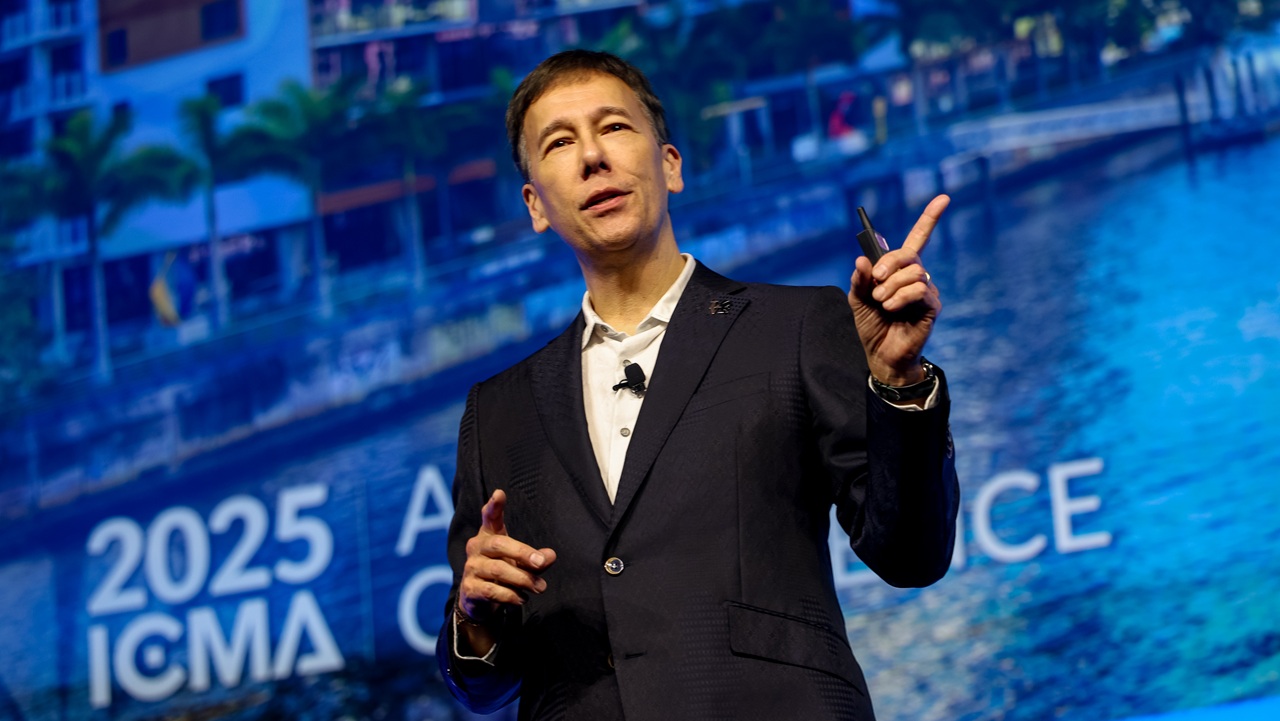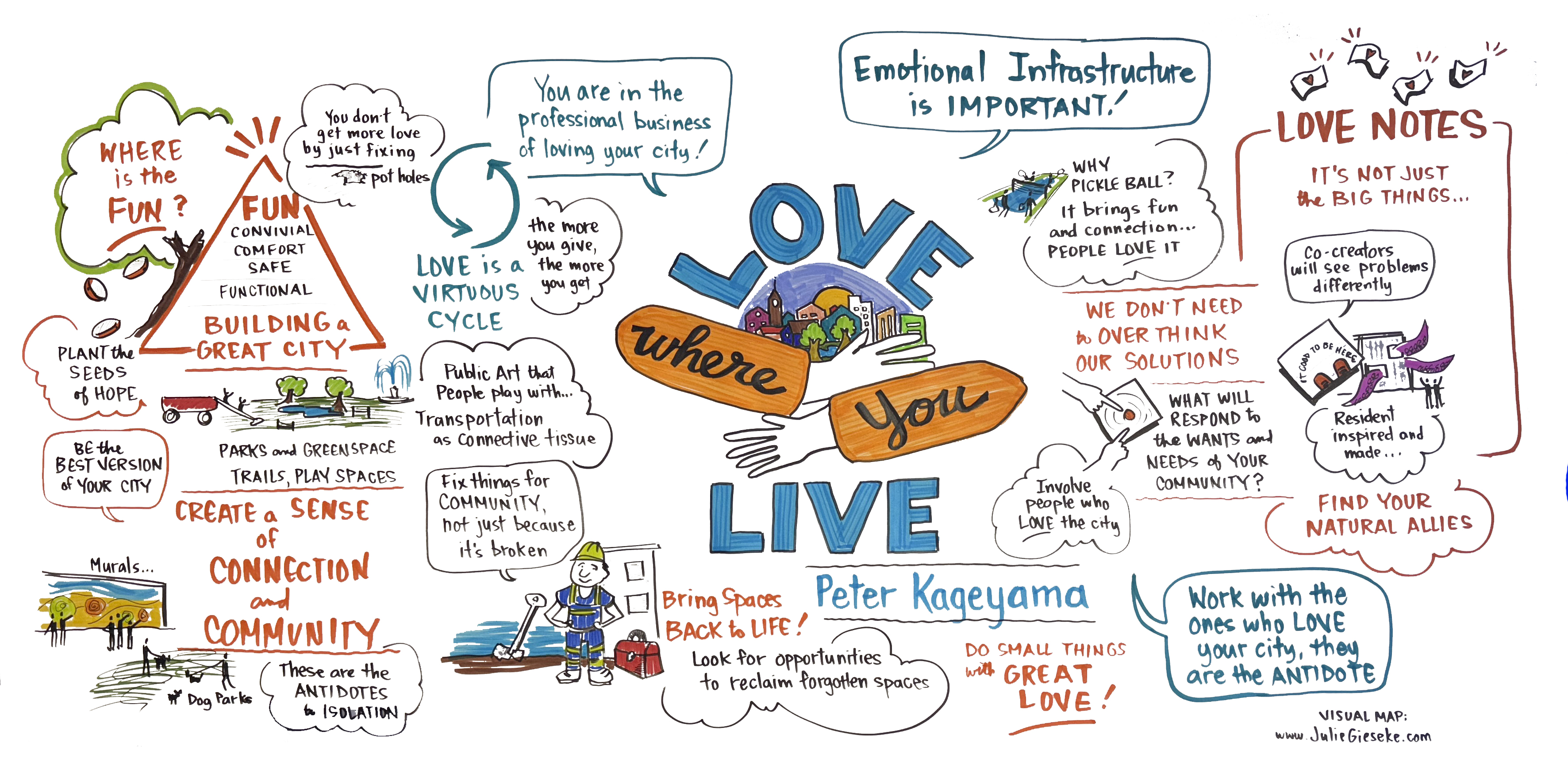
The 2025 ICMA Annual Conference ended on a high note with a closing keynote, sponsored by OpenGov, from Peter Kageyama, the bestselling author of For the Love of Cities and Love Where You Live. Known for his human-centered perspective on urban life, Kageyama invited local government leaders to reimagine their work through a lens of emotion and creativity.
“I believe all of you are in the professional business of loving your city,” he told the audience. “And if you don’t, fake it ‘til you make it.” Kageyama reminded attendees that great communities are built as much by the heart as by the hands. City/county managers are responsible for the emotional infrastructure that makes communities thrive: joy, creativity, play, pride, and that elusive ingredient that makes people say, I love where I live.
From Functional to Fun
Kageyama began by acknowledging a truth every city and county leader knows: local governments are often defined by the problems they’re expected to fix.
“Most people’s relationship with their city is defined by potholes and parking,” he said. “And you’re not going to get any love for fixing potholes. No one says, ‘Honey, let’s go for a drive and look at the smooth pavement!’”
He challenged attendees to aim higher. “We should aspire to something more than just functional and safe,” he said. “Why can’t our cities also be comfortable, convenient, connected—and yes, fun?”
He urged attendees to take that question—Where’s the fun?—back to their next staff meeting. Injecting joy into local government projects encourages creativity and engagement. “When you ask where the fun is, you invite people to think differently. You open the door to possibility.”
The Power of Small Things
That sense of possibility is at the heart of what Kageyama calls “love notes to the city.” These are small, often whimsical gestures—like public art, clever signage, unexpected recreational installations, or creative design touches—that remind residents their community is cared for. “They’re the handwritten note that comes with the gift,” he explained. “They’re the things cities give to their residents that say, ‘We see you, we care.’”
He showed examples from throughout the United States: Portland’s Mill Ends Park, billed as the world’s smallest city park; the “Exploding Chicken,” a piece of public art in Tampa that earned its nickname from locals; and in Spokane, Washington, a playground slide 27 feet in length shaped like a Radio Flyer wagon. “These small things have an outsized impact,” he said. “They make people smile. They show that somebody cared enough to make it special.”
Even basic maintenance, Kageyama noted, can become an act of civic love. He gave the example of ornate clocks found on Main Street in so many towns that often go unfixed, displaying the incorrect time for years. “When something is broken and stays broken, people notice,” he said. “They think, doesn’t somebody care? Fixing what’s broken isn’t just a functional act—it’s emotional.”

Emotional Infrastructure
Kageyama’s concept of emotional infrastructure has evolved through years of observing what makes places feel alive. Beyond roads and pipes, he said, cities depend on an invisible network of shared experiences, memories, and social connections.
“Parks, trails, dog parks, and splash pads aren’t just amenities,” he said. “They’re emotional infrastructure. They bring people together, they help us connect, and they remind us we belong somewhere.”
During the pandemic, he noted, that truth became inescapable. “When everything else shut down, people went to parks,” he said. “They rediscovered how essential those spaces are to their sense of wellness and community. I don’t think we’ll ever forget that.”
He cited Atlanta’s BeltLine as an example of a modern project that doubles as emotional infrastructure. The trail network, built on repurposed rail lines, connects neighborhoods and has become a magnet for both recreation and social life. Local residents choose jobs, apartments, and even prospective dates based on proximity to the BeltLine. “They want to live near connection.”
A Call for Creativity and Co-Creation
One of Kageyama’s strongest messages was that great places are not built solely by governments—they’re co-created by residents. “Every community has creative people—artists, entrepreneurs, and even a few lovable eccentrics—who bring a sense of play and imagination to their city,” he said. “They’re not troublemakers; they’re your allies.”
He shared stories from around the country where small, creative acts sparked larger transformations. Two University of South Florida students launched Swing Tampa Bay, a grassroots project that hung simple wooden swings in unexpected places. What started as a class assignment became a citywide movement of spontaneous joy. Residents everywhere began taking a moment out of their day to tap into a core childhood memory on a swing.
He encouraged local governments to welcome those kinds of projects, even when they’re unconventional. “You’re still the stewards of public safety and liability,” he acknowledged. “But handle your co-creators with a different set of gloves. You don’t want to crush their enthusiasm—you want to channel it.”
Love as Strategy, Not Sentiment
Throughout the keynote, Kageyama framed love not as an emotion apart from public administration, but as a strategy for civic success. When people feel emotionally connected to their place, he said, they’re more likely to volunteer, to care for public spaces, and to invest their time and creativity.
He also noted a major shift since the pandemic: the rise of remote and flexible work. “More people now have the freedom to live anywhere,” he said. “That means every community is in the business of place-making. People will choose to live where they feel something.” Consider your tourists and potential future residents and dare to make your city memorable.
For leaders, that means experimenting, even at the risk of small failures. “If you’ve never tried anything new, you’ve never failed,” he said. “But that also means you’ve never really changed.”
The Work of the Heart
Kageyama closed his keynote with a reminder that local government work, at its core, is profoundly human. “You build the places where people live their lives,” he said. “And when you do that with heart, people feel it.” Civic pride is contagious. When leaders express genuine affection for their community, residents mirror it.
“When people love their city, they take care of it,” he said. “They defend it. They dream bigger for it. And they remind the rest of us why this work matters.”
Watch ICMA TV to see more from the 2025 ICMA Annual Conference!
New, Reduced Membership Dues
A new, reduced dues rate is available for CAOs/ACAOs, along with additional discounts for those in smaller communities, has been implemented. Learn more and be sure to join or renew today!
